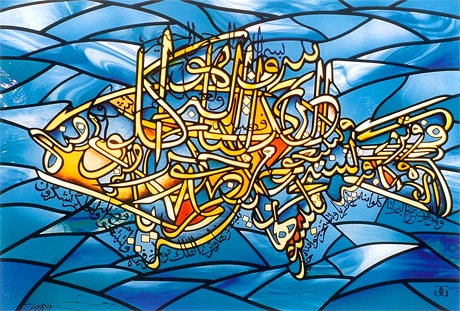 The Arab Calligraphy had emerged in the North of the Arabian Peninsula in an impact of the scripts prevailing in Hira and Anbar. Bishr ibn Abdel Malek Al-Kendy was the first to introduce writing in Mecca. Al-Kendy had learned the art of Nabatian script from the Arabian tribes who inhabited the areas of Hirah and Anbar.
The Arab Calligraphy had emerged in the North of the Arabian Peninsula in an impact of the scripts prevailing in Hira and Anbar. Bishr ibn Abdel Malek Al-Kendy was the first to introduce writing in Mecca. Al-Kendy had learned the art of Nabatian script from the Arabian tribes who inhabited the areas of Hirah and Anbar.
Arabs before Islam were interested in writing. They started to use writing in the different affairs of their lives regarding writing contracts, political and business documents, as well as, literature and poetry. So Arab nation did not suffer illiteracy in the sense that people don’t know to read and write, hence the revelation of Quran in this intellectual depth and eloquent way is a clear evidence for Arabs ability to understand and to carry His message to all people.
The first versions of the Qur’an were written in the scripts of Makki and Madani. These scripts were variants of the Jazm script and were named for cities Makki for Mekka, and Madani for Medina.
The march of the Arab calligraphy described the march of the Muslims history that shows through its ramifications the several stages experienced by Muslims during their long history and writing became a very important means for communication.
Writing and reading became the method in which Muslims recorded and preserved the Sunna, i.e Prophet’s instructions and Quranic interpretation. The Arabic language spread as more Muslims were encouraged to learn to read and write in order to comprehend Islamic instructions.
There are two main methods dominated the art of writing in the Muslim world:
1-The Dry method, in which letters are straight with sharp corners. The most famous is the Kufic line.
2-The Soft method, its letters are curved, al- Naskh line is the most famous line written in this method.
Forms of Arabic Calligraphy:
According to contemporary studies, researchers said that although scripts had different names, they were not particularly distinct from one another. We have:
The Kufic script: is a heavy monumental Arabic script which is suited for stone carving, appears in the earliest surviving Koran manuscript.
The Naskh script: Naskh means ‘copying’. It is a small script whose lines are thin and letter shapes are round.
The Thuluth script: It was round and elegant, cursive script, used in Medieval times for mosques decoration.
The Ta’liq script: It is a cursive style of lettering which was developed in Iran in the 10th century. It was widely used for royal as well as daily correspondence until the 14th century. The Ta’liq script was formulated and developed into a widely used native script which led to the invention of a lighter and more elegant version called Nasta’liq.
The Nasta’liq script: It was a combination of the Naskh and Ta’liq scripts. It was frequently used into paintings of the early Safavid era . It was considered the most elegant of the Persian script.
The Riq’a script: It is considered the simpler style of the every day writing .
The Deewani script: it is a cursive style of writing used during the period of Ottomans. It was characterized by the complexity of the lines within the letters.
Calligraphy Instruments:
The typical tools for a calligrapher included reed and brush pens, scissors, a knife for cutting the pens, an ink pot, and a sharpening tool. According to Safadi, the reed pen, which is called a ‘qalam’, remains an essential tool for a true calligrapher.
The most esteemed reeds were native to the coastal lands of the Persian Gulf. Qalams were valued objects and were traded across the entire Muslim world.
Ink was of many colors including black, brown, yellow, red, blue, white, silver, and gold. Black and brown inks were often used.
Ink preparation could take several days and involve many complex chemical processes.
Paper was also among the most important tools used by the calligraphers. It was introduced in 751 from China via Samarqand. Producing paper was a turning point in the art of writing.
Most outstanding calligraphers:
Mir Ali Tabrizi: He was the most important calligrapher in the Timurid period. He invented the Nasta’iq script and devised the rules to govern it.
Ibn Muqlah.: According to Welch (1979), Ibn Muqlah is regarded as a figure of heroic stature who laid the basis for a great art upon firm principles and who created the Six Styles of writing: Kufi, Thuluth, Naskh, Riq’a, Deewani, and Ta’liq. Ibn Muqlah (886-940) was followed by Ibn al-Bawwab in the 11th century and Yaqut al-Musta’simi in the late 13th century. The latter two men built upon Ibn Muqlah’s achievements .
There were many master Mamluk calligraphers whose works exhibit superb artistic skills including Muhammad Ibn al-Wahid, Muhammad Ibn Sulayman al-Muhsini, Ahmad Ibn Muhammad al-Ansari, and Ibrahim Ibn Muhammad al-Khabbaz. Abd al-Rahman al-Sayigh is very well-known for copying the largest-size Qur’an in Muhaqqa script.
Amal Farhat

